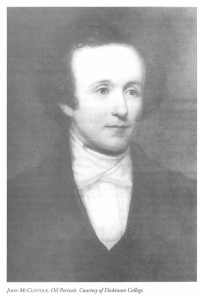Butcher Tot Lot Home | Park History | Butcher Family History | Tot Lot Improvement Project | Photo Gallery | African Americans in Carlisle
Although Carlisle sits north of the Mason-Dixon line, its history is riddled with important African American narratives that date back to the Civil War. While Pennsylvania was a free state, where no person could be born enslaved, ownership of slaves had not been illegal. As recently as 1840, two-dozen slaves were held in captivity in Cumberland County. At that time, more than three hundred free African-Americans lived in Carlisle. The history of African Americans in Carlisle is relevant to the Butcher Tot Lot because the Butcher family were African Americans; during the nineteenth century in times of increased racial tension in Central Pennsylvania, the Butcher family was able to move up in society.
The first known incident involving slavery occurred in 1832, when a slave owner from Maryland claimed slave ownership over a man living in Carlisle. He went to the Court of Common Pleas at the County Courthouse and was granted this man as his slave. However, one of the most significant events relating to slave history in Carlisle occurred fifteen years later.[1]
In the late summer of 1847 Professor John McClintock was tried before the Quarter Sessions Court of Cumberland County. He was the only white man among 34 other Carlisle residents, all black, charged with inciting a riot. It all started in June, when more than a dozen slaves escaped from Maryland into the Cumberland Valley. Near Shippensburg, two slave owners, James Kennedy and Howard Hollingsworth, caught three of the fugitives: a man, Lloyd Brown; a girl, Ann; and a woman, Hester Norman, married to a free man, George Norman, of Carlisle. In Carlisle, the owners appeared at the courthouse before the justice of the peace with the captured fugitives. It was there that the men made claims of ownership over the group based on the evidence they had gathered as sufficient proof. After this, they received a certificate delivering the fugitives into their custody. Immediately, this caused unease throughout the town, especially in the African American community. After a writ of habeas corpus was obtained, a new hearing took place to reverse the decision regarding slave ownership. After the hearing was over, trouble seemed imminent, as the streets revealed a crowd of blacks that had hung around the jail until its doors were opened.[2]
John McClintock wrote in his diary:
“After some conversation, we came our to the courthouse steps conversed there with several gentlemen, a few moments, when the coloured people were brought out to be led into the carriage which was drawn out immediately in front of the courthouse. I anticipated no outbreak & indeed was sure that the people would be ralcen off in the carriage. But as they were going in, either they attempted to escape, or others attempted to rescue them; blows were struck, as far as I could judge, by the white men first & a general riot with missiles ensued. I kept out of it, but after it was over, approached a crowd near the marker house, where I heard that a man was hurt. Found it was Mr. Kennedy, the owner; asked Dr. Mahon if he was badly hurt, he replied nor dangerously- I expressed regret and then passed on homewards.”[3]
So why did McClintock get charged for inciting a riot? Well, crowds were riled up over the hustle and bustle of the day and McClintock had stopped two men from abusing an older African American woman who had been trying to remove her husband from the crowd. This made McClintock a target for the white crowd; he ended up in jail with a bail of $300. On August 25th he stood amongst 34 African American who were also charged with inciting and aggravating a riot. Interestingly enough, Dickinson College students were active in defending the Professor’s abolitionist stance and are said to be responsible for the prevention of his firing.
The McClintock Slave Riot is significant to the history of Carlisle because it is a reminder that while Pennsylvania was above the Mason-Dixon Line, racial tension was still very prevalent. This is noteworthy in regard to the Butcher Tot Lot because it is within this tense racial climate that the Butchers moved their way up in society.
[1] Martha C. Slotten, “The McClintock Slave Riot of 1847,” Cumberland County History 17 (2000): 14-33.http://gardnerlibrary.org/journal/mcclintock-slave-riot-1847
[2] Lindsay Houpt, “Fugitive Slave Cases in Cumberland County, PA,” Cumberland County History 27 (2010): 69-77. http://gardnerlibrary.org/journal/fugitive-slave-cases-cumberland-county-pa
[3] Martha C. Slotten, “The McClintock Slave Riot of 1847,” Cumberland County History 17 (2000): 17.http://gardnerlibrary.org/journal/mcclintock-slave-riot-1847
For more on African-American history in central Pennsylvania in the nineteenth century, see the Shippensburg Cemetery article, “The North Queen Street Cemetery and the African-American Experience in Shippensburg, PA,” written by Steven B. Burg.

